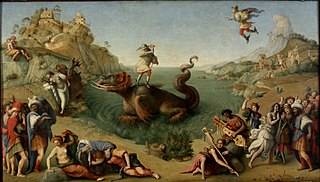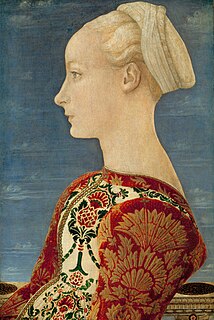
The Uffizi Gallery is a prominent art museum located adjacent to the Piazza della Signoria in the Historic Centre of Florence in the region of Tuscany, Italy. One of the most important Italian museums and the most visited, it is also one of the largest and best known in the world and holds a collection of priceless works, particularly from the period of the Italian Renaissance.

Alessandro di Mariano di Vanni Filipepi, known as Sandro Botticelli, was an Italian painter of the Early Renaissance. Botticelli's posthumous reputation suffered until the late 19th century, when he was rediscovered by the Pre-Raphaelites who stimulated a reappraisal of his work. Since then, his paintings have been seen to represent the linear grace of Early Renaissance painting.

Filippino Lippi was an Italian painter working in Florence, Italy during the later years of the Early Renaissance and first few years of the High Renaissance.

Piero di Cosimo, also known as Piero di Lorenzo, was an Italian painter of the Renaissance.

Antonio del Pollaiuolo, also known as Antonio di Jacopo Pollaiuolo or Antonio Pollaiuolo, was an Italian painter, sculptor, engraver and goldsmith during the Italian Renaissance.

The Pucci family has been a prominent noble family in Florence over the course of many centuries. A recent notable member of this family was Emilio Pucci, an Italian fashion designer who founded a clothing company after World War II.

The Martyrdom of Saint Sebastian is a work by Piero del Pollaiuolo, commissioned by the Florentine Pucci family and now in the National Gallery, London.

Portrait of a Man with a Medal of Cosimo the Elder, also known as Portrait of a Youth with a Medal, is a tempera painting by Italian Renaissance painter Sandro Botticelli. The painting features a young man displaying in triangled hands a medal stamped with the likeness of Cosimo de' Medici. The identity of the young man has been a long-enduring mystery. Completed in approximately 1475, it is on display in the Uffizi Gallery of Florence.

The Immaculate Conception with Saints is a painting by the Italian Renaissance painter Piero di Cosimo, executed between 1485 and 1505. It is housed in the Uffizi Gallery of Florence, Italy.

Hercules slaying Antaeus, c. 1460, is a painting attributed to the Florentine artist Antonio Pollaiuolo. It is a small image, 6 x 3 1/2 inches, painted in egg tempera on a panel of wood. It is in the Uffizi gallery, Florence.

Profile Portrait of a Young Lady is a 1465 half-length portrait, made with oil-based paint and tempera on a poplar panel, usually attributed to Antonio del Pollaiuolo. It is held by the Gemäldegalerie in Berlin, which describes this work as one of its most famous paintings, and as one of the most famous portraits of women from the early Italian Renaissance.

Faith is a 1470 oil on panel painting by Piero del Pollaiolo, now in the Uffizi in Florence.

Apollo and Daphne is a c.1470–1480 oil on panel painting, attributed to Piero del Pollaiolo and/or his brother Antonio). William Coningham acquired it in Rome in 1845 and in 1876 Wynne Ellis left it to the National Gallery, London, where it still hangs. It shows Daphne's transformation into a laurel tree to escape Apollo in Ovid's Metamorphoses.

Charity is a 1469 oil on panel painting by Piero del Pollaiolo, now in the Uffizi in Florence.

Prudence is a 1470 oil on panel painting by Piero del Pollaiolo, now in the Uffizi in Florence.

Justice is a 1470 oil on panel painting by Piero del Pollaiolo, now in the Uffizi in Florence.

Hope is a 1470 oil on panel painting by Piero del Pollaiolo, now in the Uffizi in Florence.

Temperance is a 1470 oil on panel painting by Piero del Pollaiolo, now in the Uffizi in Florence. It represents Temperance, one of the seven virtues of the Catholic Church.

Portrait of Galeazzo Maria Sforza is an oil on panel painting by Piero del Pollaiolo, now in the Uffizi in Florence.

Portrait of a Woman is a c.1475 tempera and oil on panel painting by Antonio or Piero del Pollaiolo. It has been in the Uffizi in Florence since 1861. Since 1861 it has been misattributed to Piero della Francesca, a young Leonardo da Vinci and Cosimo Rosselli.




















